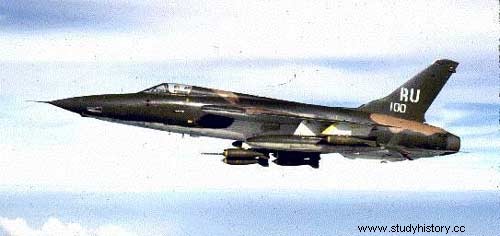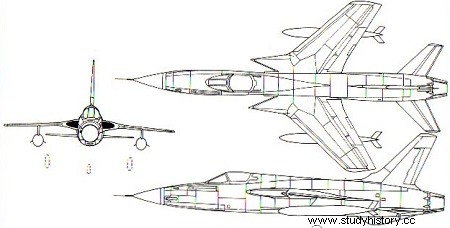
An entire air force in the hands of one man. Created in the 1960s, this slogan defines better than any technical description the operational capabilities of the Thunder-chie f, a sophisticated fighting machine, considered the best in the long line of worthwhile projects carried out by the Republic since the second world war. Designed in 1954 as an "all-weather" supersonic assault aircraft, capable of carrying conventional or nuclear weaponry, the F-105 (or Thud, as it was known in aircrew jargon) became the mainstay of Tactical Air Command and participated in the Vietnam conflict:beginning in 1963, during their first five years of service in Southeast Asia, the Thunderchiefs flew more than 75 percent of all assault missions flown by the USAF.
The Republic started the project on its own account with the intention of building a successor to the famous F-84, thus arousing the interest of the USAF, favorably impressed by the theoretical characteristics of the new machine. In 1954, the program received final approval and the United States ordered the manufacture of two prototypes, designated YF-105A. The Thunderchief presented itself as the largest and heaviest single-engine single-seat fighter of its time. To fully meet the operational requirements, the engineers had designed a huge fuselage, characterized by a hold capable of containing up to 3,630 kilos of traditional or nuclear bombs; Another 1,814 kilos of war load (later increased in quantity) could additionally be installed on five external supports, including one on the belly of the fuselage and four under the wings, while the fixed armament consisted of a cannon by 20 millimeters.
The wings had a high positive sweep and, in the first production version, also included an unusual type of air intakes intended to improve the aerodynamic efficiency of the power supply of the turbojet at supersonic speeds. The aircraft was to be propelled by the most powerful engine available at the time and, in its final form, adopted the Pratt &Whitney J75 of 10,660 kilos of thrust, power still increased thereafter in the various production versions.
The prototype flew for the first time on October 22, 1955, followed, on May 24, 1957, by the first production F-105B. The Republic only built 75 of this initial version, which began arriving in operational detachments in May 1958. The bulk of production was concentrated on the next model, the F-105D, which appeared in prototype form on June 9, 1959 Technicians considerably improved the on-board electronics of these Thunderchiefs, in particular the armament control systems, and equipped these planes with an even more powerful version (12,020 kilos of thrust) of the J75 turbojet engine. These, which entered service in 1961, were built in more than 600 copies.
In 1962, the USAF ordered the next version, which was called F-105F. It was a two-seater model of the basic type, characterized not only by dual controls, but also by all operational equipment. The Republic produced 143 F-105Fs, which it delivered from June 1963. The intensive use of the F-105Ds was accompanied by a vast modernization program, which was applied to some 350 units:modifications, dictated by the operational requirements of the Vietnamese conflict, mainly concerned the control systems for the "all weather" assault, which became even more sophisticated. These aircraft had a conspicuous “hump” on their backs that contained the new avionics. Finally, the Americans also transformed about thirty F-105F in order to install an electronic countermeasures system and literally filled them with radars and jamming devices.

Vietnam War
During the Vietnam War, this aircraft made more than 20,000 sorties, for 382 losses (nearly half of the 833 copies produced). Although less agile than the smaller MiG fighters, the United States Air Force's F-105s were credited with 27.5 enemy aircraft shot down.
In order to limit the damage caused by the Vietnamese People's Air Force, Operation Bolo, a ruse consisting of disguising F-4 fighters as F-105s, was carried out in January 1967.

dates
commissioning date :1959
date of end of use :1984
built 833
Nationalities
Constructor :USA
Users :USA
Categories Fighter Bomber
Technical and Performance Data
 Span :10.64 m.
Span :10.64 m.
Length :19.58m.
Height :5.99m.
Weight :
Maximum Weight :21,954 kg
Performance
Autonomy :3,220 km
Maximum speed :2,280 km/h at an altitude of 11,580 m
Ascending Speed :11,700 m/min
Practical ceiling :15,850m
Motorisation (engines or reactors)
 Pratt &Whitney J75-P-19 12,020 kg thrust turbojet engine
Pratt &Whitney J75-P-19 12,020 kg thrust turbojet engine
Armaments
 1 x 20mm cannon; 6,350 kg war load
1 x 20mm cannon; 6,350 kg war load
